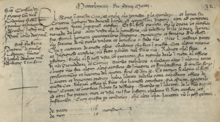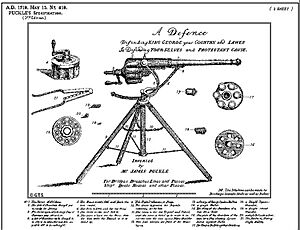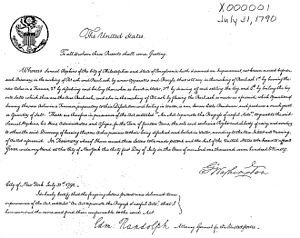History of patent law facts for kids
The history of patents and patent law is generally considered to have started with the Venetian Statute of 1474.
Early precedents
There is some evidence that some form of patent rights was recognized in Ancient Greece. In 500 BCE, in the Greek city of Sybaris (located in what is now southern Italy), "encouragement was held out to all who should discover any new refinement in luxury, the profits arising from which were secured to the inventor by patent for the space of a year." Athenaeus, writing in the third century CE, cites Phylarchus in saying that in Sybaris exclusive rights were granted for one year to creators of unique culinary dishes.
In England, grants in the form of letters patent were issued by the sovereign to inventors who petitioned and were approved: a grant of 1331 to John Kempe and his company is the earliest authenticated instance of a royal grant made with the avowed purpose of instructing the English in a new industry. These letters patent provided the recipient with a monopoly to produce particular goods or provide particular services. Another early example of such letters patent was a grant by Henry VI in 1449 to John of Utynam, a Flemish man, for a twenty-year monopoly for his invention.
The first extant Italian patent was awarded by the Republic of Venice in 1416 for a device for turning wool into felt. Soon thereafter, the Republic of Florence granted a patent to Filippo Brunelleschi in 1421. Specifically, the well-known Florentine architect received a three-year patent for a barge with hoisting gear, that carried marble along the Arno River.
Development of the modern patent system
Patents were systematically granted in Venice as of 1450, where they issued a decree by which new and inventive devices had to be communicated to the Republic in order to obtain legal protection against potential infringers. The period of protection was 10 years. These were mostly in the field of glass making. As Venetians emigrated, they sought similar patent protection in their new homes. This led to the diffusion of patent systems to other countries.
King Henry II of France introduced the concept of publishing the description of an invention in a patent in 1555. The first patent "specification" was to inventor Abel Foullon for "Usaige & Description de l'holmetre", (a type of rangefinder.) Publication was delayed until after the patent expired in 1561. Patents were granted by the monarchy and by other institutions like the "Maison du Roi" and the Parlement of Paris. The novelty of the invention was examined by the French Academy of Sciences. Digests were published irregularly starting in 1729 with delays of up to 60 years. Examinations were generally done in secret with no requirement to publish a description of the invention. Actual use of the invention was deemed adequate disclosure to the public.
The English patent system evolved from its early medieval origins into the first modern patent system that recognised intellectual property in order to stimulate invention; this was the crucial legal foundation upon which the Industrial Revolution could emerge and flourish.
By the 16th century, the English Crown would habitually grant letters patent for monopolies to favoured persons (or people who were prepared to pay for them). Blackstone (same reference) also explains how "letters patent" (Latin literae patentes, "letters that lie open") were so called because the seal hung from the foot of the document: they were addressed "To all to whom these presents shall come" and could be read without breaking the seal, as opposed to "letters close", addressed to a particular person who had to break the seal to read them.
This power was used to raise money for the Crown, and was widely abused, as the Crown granted patents in respect of all sorts of common goods (salt, for example). Consequently, the Court began to limit the circumstances in which they could be granted. After public outcry, James I of England was forced to revoke all existing monopolies and declare that they were only to be used for "projects of new invention". This was incorporated into the 1624 Statute of Monopolies in which Parliament restricted the Crown's power explicitly so that the King could only issue letters patent to the inventors or introducers of original inventions for a fixed number of years. It also voided all existing monopolies and dispensations with the exception of:
- ...the sole working or making of any manner of new manufactures within this realm to the true and first inventor and inventors of such manufactures which others at the time of making such letters patent and grants shall not use...
The Statute became the foundation for later developments in patent law in England and elsewhere.
Important developments in patent law emerged during the 18th century through a slow process of judicial interpretation of the law. During the reign of Queen Anne, patent applications were required to supply a complete specification of the principles of operation of the invention for public access. Patenting medicines was particular popular in the mid-eighteenth century and then declined. Legal battles around the 1796 patent taken out by James Watt for his steam engine, established the principles that patents could be issued for improvements of an already existing machine and that ideas or principles without specific practical application could also legally be patented.
This legal system became the foundation for patent law in countries with a common law heritage, including the United States, New Zealand and Australia. In the Thirteen Colonies, inventors could obtain patents through petition to a given colony's legislature. In 1641, Samuel Winslow was granted the first patent in North America by the Massachusetts General Court for a new process for making salt.
Towards the end of the 18th century, and influenced by the philosophy of John Locke, the granting of patents began to be viewed as a form of intellectual property right, rather than simply the obtaining of economic privilege. A negative aspect of the patent law also emerged in this period - the abuse of patent privilege to monopolise the market and prevent improvement from other inventors. A notable example of this was the behaviour of Boulton & Watt in hounding their competitors such as Richard Trevithick through the courts, and preventing their improvements to the steam engine from being realised until their patent expired.
Consolidation
The modern French patent system was created during the Revolution in 1791. Patents were granted without examination since inventor's right was considered as a natural one. Patent costs were very high (from 500 to 1500 francs). Importation patents protected new devices coming from foreign countries. The patent law was revised in 1844 - patent cost was lowered and importation patents were abolished. The revision saw the introduction of the Breveté SGDG, which excluded any guarantees that the patented item would actually satisfy its specification.
The Patent and Copyright Clause of the United States Constitution was proposed in 1787 by James Madison and Charles Cotesworth Pinckney. In Federalist No. 43, Madison wrote, "The utility of the clause will scarcely be questioned. The copyright of authors has been solemnly adjudged, in Great Britain, to be a right of common law. The right to useful inventions seems with equal reason to belong to the inventors. The public good fully coincides in both cases with the claims of the individuals."
The first Patent Act of the U.S. Congress was passed on April 10, 1790, titled "An Act to promote the progress of useful Arts." The first patent was granted on July 31, 1790 to Samuel Hopkins for a method of producing potash (potassium carbonate).
The earliest law required that a working model of each invention be submitted with the application. Patent applications were examined to determine if an inventor was entitled to the grant of a patent. The requirement for a working model was eventually dropped. In 1793, the law was revised so that patents were granted automatically upon submission of the description. A separate Patent Office was created in 1802.
The patent laws were again revised in 1836, and the examination of patent applications was reinstituted. In 1870 Congress passed a law which mainly reorganized and reenacted existing law, but also made some important changes, such as giving the commissioner of patents the authority to draft rules and regulations for the Patent Office.
See also
- History of copyright law
- History of United States patent law
- United States patent case law
- Scire facias




